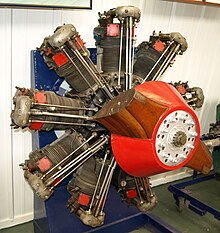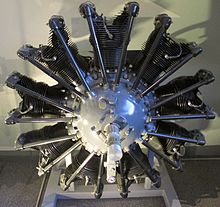Nakajima Kotobuki
| Nakajima Hikōki | |
|---|---|
| Image does not exist |
|
| Kotobuki | |
| Production period: | 1930 – unknown |
| Manufacturer: | Nakajima Hikōki |
| Developing country: |
|
| First run: | 1930 |
| Working principle: | Otto |
| Motor design: | Radial engine |
| Cylinder: | 9 |
| Drilling: | 146 mm |
| Hub: | 160 mm |
| Displacement: | 24,100 cm 3 |
| Mixture preparation: | Carburetor |
| Engine charging: | no |
| Cooling system: | Air cooling |
| Power: | 405-570 kW |
| Dimensions: | 350 kg |
| Previous model: | none |
| Successor: | Hikari |
The Nakajima Ha-1 Kotobuki ( Japanese寿, dt. "Longevity") was an aircraft engine from the Japanese manufacturer Nakajima Hikōki . The radial engine was built under license by the British engine Bristol Jupiter
development and construction
In 1917, Chikuhei Nakajima founded an aircraft construction company in Ojima (now Ōta ) in Gunma Prefecture . The first aircraft - the Nakajima Type 1 - was built in 1918. The machine was powered by a US engine. In 1920 the company sent Kimihei Nakajima to France to research European advances in aircraft construction, and in 1922 it began manufacturing its own engines in a new factory in Tokyo . Were built engines based on the air-cooled two-cylinder piston engine Lawrance A-3 .

At that time, the Lawrance engine was a rarity, as most contemporary air-cooled engines were rotary engines whose cylinders rotated together with the propeller . Kimihei, however, heard of a conventional reciprocating engine with good cooling capacity that was being developed in England at the time . He noticed the British Gloster Gamecock fighter with its Bristol-Jupiter engine , the design of which was ahead of its time. The engine had tappets with automatic valve clearance compensation , spiral tubes for even intake distribution and four valves per cylinder. In 1925 he received a building license for Jupiter. After a visit by two engineers from the Bristol Aircraft Company , production of the Jupiter types 6 with a nominal output of 420 hp (309 kW ) and 7 with 450 hp (331 kW) and Supercharger began at Nakajima in 1927.
After evaluating the nine-cylinder star engine series Pratt & Whitney Wasp , Nakajima tried to combine the advantages of Jupiter with the rational construction of the Wasp. Nakajima built a number of individual pieces with the designations AA, AB, AC and AD for technical research purposes. The subsequent design with the designation AE was ultimately promising with a bore of 160 millimeters and a piston stroke of 170 millimeters.
Prototypes were built and function tested , but the design was initially abandoned due to the complex structure. Nakajima continued to experiment with different cylinder designs. Finally, in 1929, the AH design was completed with a bore of 146 millimeters, a stroke of 160 millimeters and a displacement of 24.1 liters. This model was the final version of the development.
In June 1930 the first prototype was finished and passed the endurance tests for approval. Flight tests were then carried out with a Nakajima A2N . In December 1931 the engine was accepted by the Imperial Japanese Navy for the Nakajima C3N under the designation Ha-1 Ko. With this, Nakajima had developed the first Japanese air-cooled nine-cylinder engine. The engine was given the name Kotobuki because of its connection to Jupiter.
The Kotobuki was further developed into the Hikari with a bore of 160 millimeters, a stroke of 180 millimeters, a displacement of 32.6 liters and a rated output of 720 hp (530 kW), which was used in the aircraft types Nakajima A4N and Yokosuka B4Y .
In order to increase the performance further, the basic construction was finally expanded to fourteen cylinders in two rows and built under the designation Nakajima Ha-5 .
Versions
- 2-quay-1
- Nominal output 585 PS (430 kW )
- 2-quay-3
- Nominal output 610 hp (449 kW)
- 3-quay
- Rated output 710 hp (522 kW)
use
- Mitsubishi A5M
- Mitsubishi K3M
- Mitsubishi Ki-18
- Nakajima A1N2
- Nakajima A2N
- Nakajima Ki-8
- Nakajima Ki-27
- Nakajima E4N
- Nakajima E8N
- Nakajima Ki-34
- Nakajima type 91
See also
Individual evidence
- ↑ a b c d e Engine development at Nakajima 1923 - 1945. Classic Airplane Museum, accessed on March 24, 2020 (English).
- ^ Bill Gunston: World Encyclopedia of Aero Engines . Patrick Stephens, Cambridge 1989, ISBN 1-85260-163-9 , pp. 104 (English).
